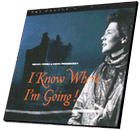

UK comedy
1945
bw 91 min.
Director: Michael Powell and Emeric Pressburger
CLV: $69.95 - available
2 discs, catalog # CC1389L

I Know Where I'm Going! is
a love story which is also a fable. Joan Webster thinks she knows exactly where
she's going: to marry the richest industrialist in Britain. But when the
elements stop her from reaching a remote Scottish island where the wedding is
due to take place, she gradually realizes that fate -- and a young navy officer on
leave -- are trying to tell her something. Powell and Pressburger had sprung to
fame among Britain's World War II filmmakers with such original contributions
to the war effort as 49th Parallel, One of Our Aircraft Is Missing, and The
Life and Death of Colonel Blimp. With the war's end in sight, they had turned
to more personal and speculative themes in A Canterbury Tale. This, they felt,
was the first salvo in a "crusade against materialism" -- an attempt to remind
their war-weary audience what it had been fighting for. Next they were due to
tackle a big film about the rocky state of Anglo-American relations (which
would eventually become A Matter of Life and Death) but in late 1944 there was
no Technicolor stock available. What could be made quickly and in black and
white?, Powell asked Pressburger. The answer was something about a girl who
can't reach an island, and by the time she can, she no longer wants to go. Why
can't she go? demanded Powell. "Let's make the film and find out," was
Pressburger's response. Pressburger recalled that the script of I Know Where
I'm Going! seemed almost to write itself. It included many elements close to
the filmmakers' hearts: Pressburger's concern for the fate that shapes
individual lives and his belief that "kindness rules the world, not money,"
combined with Powell's deep love for the Scottish islands and his technical
virtuosity, here required to combine location filming and studio special
effects for a spectacular whirlpool sequence which brings together all the
film's themes -- moral, mythic and elemental -- in a thrilling climax. There was also
a more personal reason for Pressburger to look into the future that awaited a
young woman on the threshold of post-war life, and for the snapshot prologue
showing Joan's determination from a very early age. His daughter Angela had
been born in 1941. For Powell, it was a chance to return to his beloved
Scotland, and to fall in love with Pamela Brown during the filming. The
Archers, as their company was called, had long wanted to work with one of the
leading young actresses of the time, Wendy Hiller. Now she was perfect for the
headstrong careerist Joan, who must learn to follow her heart rather than her
head. It was a topical theme, perhaps even more then the Archers could have
realized in late 1944. For after nearly six years of war, Britain was stirring
with a new idealism. Countless men and women in uniform and in the war
industries dreamed of a fairer world after victory. When party politics
returned in mid-1945 after the wartime National Coalition, Churchill made clear
his opposition to more of the social reforms which had already been introduced
during the war. The result of the "khaki election" was a resounding vote for
socialism and a rejection of Churchill's paternalism. Powell and Pressburger
were no revolutionaries, but they were in tune with the times. No other British
film of the period captures so well the widespread hostility towards those who
had profited from the war and the determination to create a new world based on
equality and honesty. Torquil (Roger Livesey) is the traditional "Laird" of the
island, who has been fighting for his country, yet forced by poverty to rent
his birthright to "the rich man." His re-education of Joan is the turning of
Britain towards a "New Jerusalem." But the Archers wanted to move rather than
moralise. Even more effectively than A Canterbury Tale, I Know Where I'm Going!
succeeds in spinning a web of myth and evocative symbolism around its central
search for self-discovery. Scenes like the traditional Céildhe, where Torquil
translates a Gaelic song to Joan which first puts into words what neither of
them has admitted, and the eerily-lit bedroom where Joan first admits her
doubts about the marriage to Sir Robert, have a rare cinematic intensity.
Powell and Pressburger had yet to launch into the glorious expressionism that
would lead to The Red Shoes and The Tales of Hoffmann, but they were already
reaching far beyond conventional realism. From Joan's "Tartan dream" as she
travels north to Scotland, to the epic drama of the Corryvreckan whirlpool
(inspired by Cecil B. DeMille's parting of the Red Sea in The Ten
Commandments), I Know Where I'm Going! boldy defies the sober style of much
World War II cinema. It is this which makes it distinctively modern. Martin
Scorsese recalls first seeing it just before he started shooting Raging Bull
and being "overwhelmed by its illustration of love laced with mysticism."
Modern, yet also timeless. At the end, Joan and Torquil emerge purified from
the tests they have undergone, like the lovers of a latter-day Magic Flute.
—Ian Christie
Credits
Production, screenplay and directiov: Michael Powell and Emeric Pressburger
Director of Photography: Erwin Hillier
Editor: John Seabourne
Music: Allan Gray
Art Director: Alfred Junge
Transfer
New digital transfer manufactured from a 35mm preservation
print recently manufactured by the British Film Institute from the original
nitrate elements. Approved by director of photography Erwin Hillier.
Index of Films


Buy CLV |
View Items |
Checkout
Ordering Information |
Criterion |
Home Vision
|
|

|





